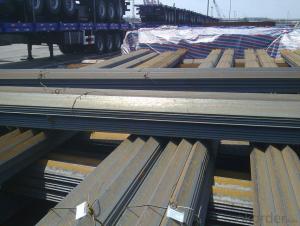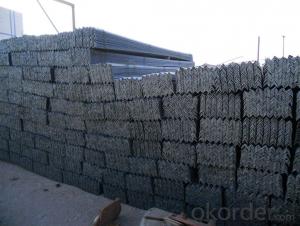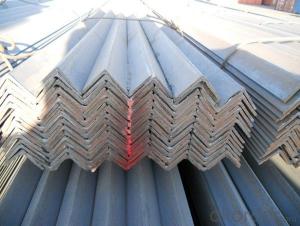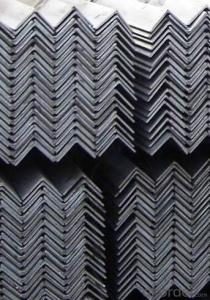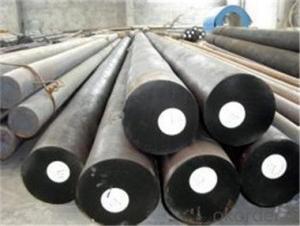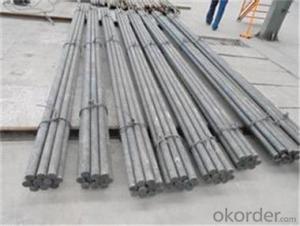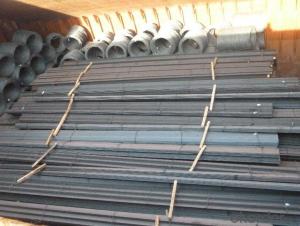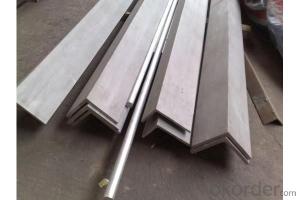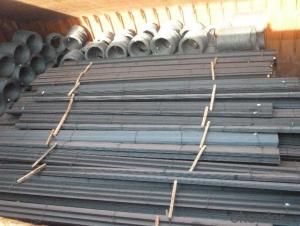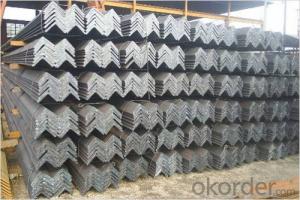Offer MS Hot Rolled Equal Angle Bars From CNBM
- Loading Port:
- Tianjin
- Payment Terms:
- TT OR LC
- Min Order Qty:
- 25 m.t.
- Supply Capability:
- 10000 m.t./month
OKorder Service Pledge
OKorder Financial Service
You Might Also Like
Specification
OKorder is offering high quality Hot Rolled Steel Angle at great prices with worldwide shipping. Our supplier is a world-class manufacturer of steel, with our products utilized the world over. OKorder annually supplies products to European, North American and Asian markets. We provide quotations within 24 hours of receiving an inquiry and guarantee competitive prices.
Product Applications:
Hot Rolled Steel Angle are ideal for structural applications and are widely used in the construction of buildings and bridges, and the manufacturing, petrochemical, and transportation industries.
Product Advantages:
OKorder's Steel Angle are durable, strong, and resist corrosion.
Main Product Features:
· Premium quality
· Prompt delivery & seaworthy packing (30 days after receiving deposit)
· Corrosion resistance
· Can be recycled and reused
· Mill test certification
· Professional Service
· Competitive pricing
Product Specifications:
Manufacture: Hot rolled
Grade: Q195 – 235
Certificates: ISO, SGS, BV, CIQ
Length: 6m – 12m, as per customer request
Packaging: Export packing, nude packing, bundled
Sizes: 25mm-250mm | ||
a*t | ||
25*2.5-4.0 | 70*6.0-9.0 | 130*9.0-15 |
30*2.5-6.6 | 75*6.0-9.0 | 140*10-14 |
36*3.0-5.0 | 80*5.0-10 | 150*10-20 |
38*2.3-6.0 | 90*7.0-10 | 160*10-16 |
40*3.0-5.0 | 100*6.0-12 | 175*12-15 |
45*4.0-6.0 | 110*8.0-10 | 180*12-18 |
50*4.0-6.0 | 120*6.0-15 | 200*14-25 |
60*4.0-8.0 | 125*8.0-14 | 250*25 |
FAQ:
Q1: Why buy Materials & Equipment from OKorder.com?
A1: All products offered byOKorder.com are carefully selected from China's most reliable manufacturing enterprises. Through its ISO certifications, OKorder.com adheres to the highest standards and a commitment to supply chain safety and customer satisfaction.
Q2: How do we guarantee the quality of our products?
A2: We have established an advanced quality management system which conducts strict quality tests at every step, from raw materials to the final product. At the same time, we provide extensive follow-up service assurances as required.
Q3: How soon can we receive the product after purchase?
A3: Within three days of placing an order, we will begin production. The specific shipping date is dependent upon international and government factors, but is typically 7 to 10 workdays.
Images:

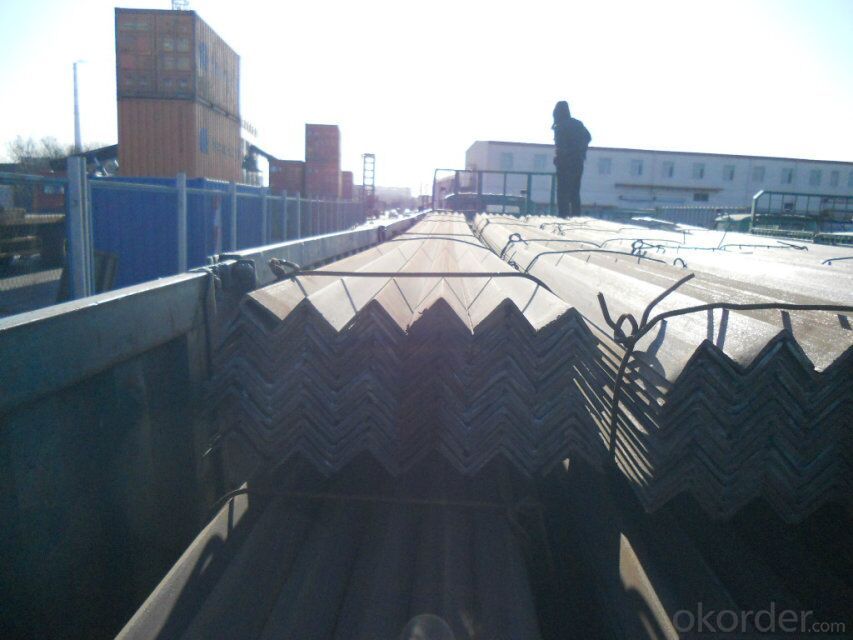
- Q: What are the different methods for cleaning steel angles?
- To effectively clean steel angles, one can employ various methods: 1. Mechanical Cleaning: By utilizing tools like wire brushes, sandpaper, or abrasive wheels, one can physically scrub away dirt, rust, or contaminants from the steel angles. This method is ideal for light cleaning and can be done manually or with the assistance of power tools. 2. Chemical Cleaning: Stubborn stains, rust, or corrosion on steel angles can be eliminated using chemicals. Acid-based cleaners, such as phosphoric acid or hydrochloric acid, are commonly employed for this purpose. It is crucial to handle these chemicals with care and follow the manufacturer's instructions to ensure safety and prevent any damage to the steel. 3. Electrolytic Cleaning: This method involves immersing the steel angles in an electrolyte solution and applying an electrical current. The electrical current causes the rust or contaminants to dissolve and separate from the surface. Electrolytic cleaning is particularly effective for heavily rusted steel angles, but specialized equipment may be required. 4. High-Pressure Water Cleaning: By utilizing high-pressure water jets, dirt, grime, and loose rust can be effectively removed from steel angles. This environmentally friendly method does not require the use of chemicals. However, it may not be as effective for stubborn stains or heavy corrosion. 5. Blasting: Blasting entails propelling abrasive particles, such as sand, grit, or beads, at high speeds onto the surface of the steel angles. This process aids in the removal of rust, paint, and other contaminants. It is commonly used for heavy-duty cleaning or surface preparation before painting or coating. Choosing the appropriate method depends on the level of contamination, the condition of the steel angles, and the desired outcome. In some instances, a combination of methods may be necessary to achieve optimal results.
- Q: Can steel angles be used in the construction of airport terminals?
- Yes, steel angles can be used in the construction of airport terminals. Steel angles are commonly used in construction for their strength, durability, and versatility. They are often used in framing, supports, and bracing structures. In airport terminal construction, steel angles can be used for various applications such as supporting structural beams, framing windows and doors, creating partitions, and reinforcing walls and columns. Additionally, steel angles can be easily welded, bolted, or fastened together, allowing for efficient construction and flexibility in design. Overall, steel angles are a reliable and cost-effective choice for the construction of airport terminals.
- Q: What are the common thicknesses of steel angles?
- The specific application and industry requirements determine the varying common thicknesses of steel angles. Examples of frequently utilized thicknesses for steel angles are 1/8 inch, 3/16 inch, 1/4 inch, 3/8 inch, and 1/2 inch. These thicknesses find common usage in construction, manufacturing, and structural applications. It is worth noting that thicker steel angles offer enhanced strength and durability, whereas thinner angles are suitable for lighter applications. Ultimately, the decision regarding thickness depends on the specific load-bearing requirements and considerations of the structural design.
- Q: How do you calculate the effective length of a steel angle?
- To calculate the effective length of a steel angle, you need to consider its end conditions and support conditions. It is determined by analyzing the buckling behavior and stability of the angle under different loading conditions. This involves considering factors such as fixed or pinned ends, bracing conditions, and the angle's geometric properties. By applying relevant formulas or structural analysis methods, you can determine the effective length and use it to assess the angle's structural stability and design requirements.
- Q: What does "angle length" and "limb width" mean?
- The width of a limb refers to the width of the point to the edge of the angle, and the length of the limb corresponds to the length of the edge;Angle called angle, the steel strip is perpendicular to each other on both sides into the corner. There are equal angles and unequal angles. The two sides of an equal angle steel are equal in width. The specifications are expressed in millimeters of edge width * edge width * edge thickness. Such as "/ 30 x 30 x 3", that is 30 mm width equal angle, edge thickness of 3 mm.
- Q: Can steel angles be used for framing windows or doors?
- Yes, steel angles can be used for framing windows or doors. Steel angles are commonly used in construction for their strength and durability. They provide structural support and stability when used as framing material. Steel angles can be easily customized and cut to the desired length, making them suitable for framing windows and doors of various sizes. Additionally, steel angles can be welded or bolted together to create a sturdy frame that can withstand heavy loads and provide the necessary support for windows and doors.
- Q: How do you prevent galvanic corrosion between steel angles and aluminum components?
- To prevent galvanic corrosion between steel angles and aluminum components, there are several measures you can take: 1. Use a barrier: Apply a barrier between the steel and aluminum surfaces, such as a non-conductive coating or a layer of paint. This will create a physical barrier that prevents direct contact between the two metals, reducing the likelihood of galvanic corrosion. 2. Apply insulating tape or gaskets: Place insulating tape or gaskets made of non-conductive materials, such as rubber or plastic, between the steel angles and aluminum components. This acts as a buffer, preventing direct contact and minimizing the risk of galvanic corrosion. 3. Select compatible metals: When designing or choosing components, opt for metals that are more compatible with each other. For instance, using stainless steel or galvanized steel instead of regular steel can reduce the risk of galvanic corrosion when paired with aluminum. 4. Use isolation techniques: Isolate the steel angles and aluminum components using isolation techniques such as plastic or rubber spacers. These spacers separate the metals, preventing direct contact and minimizing the potential for galvanic corrosion. 5. Apply corrosion inhibitors: Apply corrosion inhibitors, such as special coatings or compounds, to the steel and aluminum surfaces. These inhibitors create a protective layer that helps prevent galvanic corrosion. 6. Control the environment: Galvanic corrosion is accelerated in the presence of moisture, saltwater, or acidic environments. Minimize the exposure of steel angles and aluminum components to these corrosive elements by ensuring proper ventilation, drainage, and maintaining appropriate protective coatings. It is important to carefully consider the specific requirements and conditions of your application when choosing the most appropriate method or combination of methods to prevent galvanic corrosion between steel angles and aluminum components. Consulting with corrosion experts or engineers can provide valuable insights and guidance tailored to your specific situation.
- Q: Can steel angles be used as handrails?
- Yes, steel angles can be used as handrails. Steel angles are commonly used in construction and can provide strength and durability when used as handrails. They can be easily installed and offer a stable grip for users. However, it is important to ensure that the steel angles meet safety standards and comply with local building codes to ensure the handrails can support the required load and provide adequate protection for users.
- Q: How do you determine the required angle length for a specific application?
- To determine the required angle length for a specific application, there are several factors that need to be considered. Firstly, the purpose of the angle in the application needs to be identified. Is it going to be used for structural support, bracing, or as a decorative element? This will help determine the level of strength and stability required, which in turn will influence the length of the angle. Next, the load or weight that the angle needs to bear should be assessed. Understanding the amount of force or pressure that will be applied to the angle will help determine the appropriate length. A heavier load may require a longer angle to distribute the weight effectively and prevent any bending or failure. The material of the angle is another important consideration. Different materials have varying levels of strength and durability. For example, steel angles are stronger than aluminum angles. The material's properties, such as tensile strength and resistance to corrosion, will impact the length required for the specific application. Additionally, the specific geometry and configuration of the application should be taken into account. Factors such as the overall dimensions, desired angle of inclination, and any additional supports or attachments need to be considered. These factors may influence the length needed to ensure proper fit, function, and stability. Finally, industry standards and regulations should be consulted to ensure compliance and safety. Certain applications may have specific guidelines for the length of angles to be used, especially in fields like construction or engineering. Overall, determining the required angle length for a specific application requires a comprehensive analysis of the purpose, load, material, geometry, and relevant standards. Consulting with experts or engineers in the field can also provide valuable insights and guidance.
- Q: What are the different types of corrosion that can affect steel angles?
- Steel angles can be affected by various types of corrosion, including: 1. Uniform corrosion: This common type of corrosion evenly deteriorates the entire surface of the steel angle. It usually occurs due to exposure to moisture and oxygen in the surrounding environment. 2. Pitting corrosion: Characterized by the formation of small pits or holes on the steel angle's surface, this type of corrosion happens when localized areas of the metal come into contact with more aggressive corrosive agents, such as chloride ions or acidic substances. 3. Galvanic corrosion: When two different metals are exposed to an electrolyte like water or saltwater, galvanic corrosion takes place. In this process, the more active metal (anode) corrodes while the less active metal (cathode) remains protected. 4. Crevice corrosion: Confined spaces or crevices where stagnant water or moisture accumulates can lead to crevice corrosion. The lack of oxygen and the concentration of corrosive agents can cause localized corrosion and degradation of the steel angle. 5. Filiform corrosion: This type of corrosion manifests as thread-like filaments on the steel angle's surface. It is typically triggered by the presence of moisture, oxygen, and contaminants like salts or organic compounds. 6. Stress corrosion cracking: Stress corrosion cracking occurs when a combination of tensile stress and a corrosive environment causes cracks to develop in the steel angle. This type of corrosion is particularly dangerous as it can result in sudden and catastrophic failure of the structure. It is important to acknowledge that the severity and probability of each corrosion type can vary depending on factors such as the environment, exposure to corrosive agents, and the quality of the steel angle. Regular inspections, maintenance, and appropriate protective coatings can help mitigate the impact of corrosion on steel angles.
Send your message to us
Offer MS Hot Rolled Equal Angle Bars From CNBM
- Loading Port:
- Tianjin
- Payment Terms:
- TT OR LC
- Min Order Qty:
- 25 m.t.
- Supply Capability:
- 10000 m.t./month
OKorder Service Pledge
OKorder Financial Service
Similar products
Hot products
Hot Searches
Related keywords
